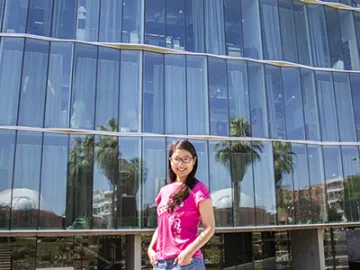Another Wavelength: Xiaoyin Zhu

This month on Another Wavelength, we learn more about fifth-year Ph.D. student Xiaoyin Zhu, a native of Changchun, China, who received her bachelor's and master's degrees from the Changchun University of Science and Technology.
What brought you to optics?
In China, we're driven to select our field of study before entering college. It was hard to decide because I was not familiar with any of the fields. The college I went to is well-known for its optical engineer major. So I chose an optical-related one: measurement and control technology and instrumentation. We took many engineering classes in optics, mechanics, electronics and computer science as well as material science. I wasn’t sure which field I should go into, even after exploring so many subjects, until I took optical labs. I found all the labs were really fun and thought maybe optics was the field I could try. I started paying more attention to optics and then I continued my master’s study majoring in optical engineering. After the first year of study, I decided to pursue more advanced optical technologies abroad. All these experiences brought me here today. It turned out that I got lucky to choose such an interesting field.

Who would you call your science hero?
There are many great scientists who inspired me, but only one led me to pursue optics as my career: Daheng Wang, who is known as the “father of modern Chinese optics” and also the founder of my college, Changchun University of Science and Technology. He is an optics pioneer, the main founder of Changchun Institute of Optics and Fine Mechanics, and its first director, where he led the development of China's first crucible of optical glass, the first electron microscope and the first laser. There is a scholarship and special program in my college that gathers the top students to do some creative projects in order to memorialize him. There is also an asteroid, which was discovered on Feb. 15, 1997, named "17693 Wangdaheng" to honor his great achievements. He is the one who makes me believe optics can change the world.
Describe your research in 20 words or fewer.
Optical and mechanical design of endoscopes and system testing.
Describe your research in 200 words or fewer.
I work in professor Rongguang Liang’s group focusing on endoscope design and system testing. The project I finished last semester was building and testing of a novel dual-view colonoscope. This colonoscope allows the user to see both the front and radial views at the same time while keeping the overall size of the system as small as only 6 millimeters in diameter. The results show that our new system improved the colonoscope detection ability from 50 percent to 83 percent, which is very promising.

Left: Optical design of the duel-view colonoscope. Right: Image taken through the duel-view colonoscope.
The current project I’m working on is to design a 2-millimeter dual-view colonoscope, which not only makes the size smaller, but also increases the field of view, allowing the users to see a larger field with a better image quality. Another project I am working on is an investigation of the possibility of using different gel materials such as PDMS, optical encapsulation gel and UV glues to replace one or multiple elements in the optical imaging system. If the optical and mechanical properties of these materials could meet the requirements of our imaging system, we could successfully make the endoscopy system smaller and lighter without sacrificing image quality.
Name three neat facts about you.
- I have been collecting quarters for about three years, but I am still missing American Samoa, Guam and the Commonwealth of Puerto Rico.
- My name, Xiaoyin, is “筱茵” in Chinese, which means "green and strong bamboo."
- I started playing "Super Smash Bros" (I always die because of suicide – walking out of the stage) and love to play in “the chair”!
